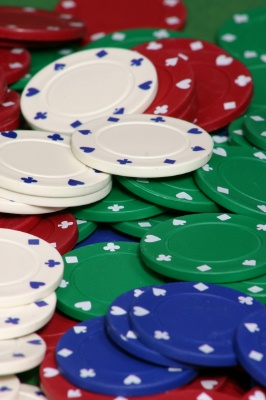|
|

Buy -
1. To bluff, as in "buy the pot"
2. To post all blinds, so that on the following hand, they receive the button.
Buying the pot is the same as bluffing at a pot. Although it can be done in any game, it is most commonly done in
No Limit where a player can make a
sizeable bet and drive out drawing hands.
When a player senses that others are weak, he may attempt to “buy the pot.” He does this by betting more than he thinks
his opponents are willing to call. Buying the pot is a common practice in No-Limit games, where players may bet any
amount. It is much more difficult to try to buy the pot in a Limit game, although it can be done. This is because in a
Limit game the bettor is restricted to betting the structured bet amount, which is often a fraction of the size of the
pot. Since the size of the bet is often small compared to the size of the pot in Limit games, your opponents will tend
to make some rough calls. Obviously, this can make bluffing difficult
Players who attempt to buy the pot are making a risk/reward decision. A player who attempts to buy the pot will often
bet about the same amount as is in the pot, or slightly less. There is a good reason for this. A smaller bet will be
called too often, and a larger bet assumes a great deal of additional risk without proportionally increasing the chance
of success. Imagine that the pot is $50. If you try to buy the pot for $2, your chance of success will be very low; you
will be wasting $2 and missing an opportunity for a successful buy. If you bet $500, you will succeed in buying the pot
most of the time, but in the long run you will be caught too often to make the play profitable. Betting $50 will win
you a slightly lower percentage of pots than betting $500, but your expected return on your bet will be much higher in
the long run. You can see that if you are going to try to buy the pot, you need to think about how much you are
risking, and what you think your chances of success are. As a rule of thumb, if you think that your bet will work more
than 50% of the time, you can bet up to the amount of the pot, without having expectation turn negative.
Buying the button allows for new players to come into the game without having to wait for the
button to pass them. Say for example, a
player leaves a game when it is his big blind
and another player gets seated after a new hand was dealt. That player would be able to buy the button and post the small
and big blind. The big blind would be a live bet and the
small blind would be pulled into the
middle as part of the pot. Players can also buy
the button if they owe blinds because they missed their blinds for one reason or another (bathroom or cigarette break).
Another way the term buy is when it is combined with the word "short" as in "buy short" or "short buy."
In most card rooms, existing players may rebuy for less than the minimum buy-in amount. This is called “buying short,” and the
unit of chips bought is called a “short buy.” This is allowed as a courtesy to players who have already lost at least one
buy-in and may not have enough money for another minimum buy. Rules regarding buying short vary from casino to casino.
Some casinos only allow each player one short buy per day. More commonly, a player is allowed to buy short if their previous buy
was a full buy (at least the minimum), without any daily limit. Some casinos may allow players to add any amount at any time to
their existing stack of chips without considering it a short buy, and only restrict purchases after a player has gone all-in.
Leaving yourself short stacked
is generally a bad idea. If you do not have enough chips to complete the current hand, it will seriously restrict your
options. If you have the best hand, you will not get paid if you have no chips to bet. You will also allow your
opponents to draw for free if you run out of chips with the best hand When you run low on chips you also reduce your
opponents’ fear of a check-raise, so
they can bet with impunity if you check. You also may decide to check when you should bet, in an ill fated attempt to conserve
your dwindling stack.
You can see that it is much better to have enough chips to play effectively and correctly. If you have enough money in
your pocket you should always make a full buy. If you are not comfortable risking another full buy, then you have lost
enough and it is time to quit the game. If you are short money, and only have a short buy, the game must be very good
in order to justify it. In this case, your expectation must be high enough to offset the substantial disadvantage you
receive by being short stacked.
Usage: Buy the Pot, Buy the Button, Bought
Previous Poker Term: Button
Next Poker Term: Buy-In |
|









